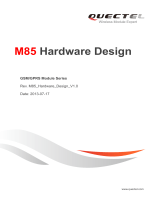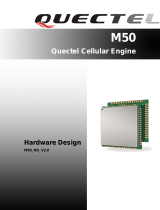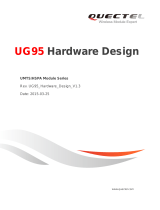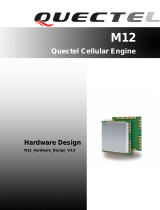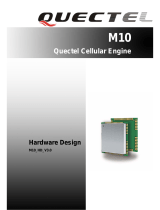
Smart Machine Smart Decision
SIM800H_Hardware_Design_V1.01 4 2013-08-20
4.8.3. Design Considerations for SIM Card Holder...................................................................................... 40
4.9. PCM Interface.....................................................................................................................42
4.9.1. PCM Multiplexing Function ............................................................................................................... 43
4.9.2. PCM Interface ..................................................................................................................................... 43
4.9.3. LCD Display/SPI Interface ................................................................................................................. 44
4.9.4. SD Card Interface................................................................................................................................ 44
4.10. Keypad Interface.................................................................................................................45
4.10.1. Keypad Multiplexing Function........................................................................................................ 47
4.11. I2C Bus ...............................................................................................................................47
4.11.1. I2C Multiplexing Function .............................................................................................................. 48
4.12. General Purpose Input/Output (GPIO) ...............................................................................48
4.13. ADC .................................................................................................................................... 48
4.14. PWM ...................................................................................................................................48
4.14.1. PWM Multiplexing Function........................................................................................................... 49
4.15. Network Status Indication...................................................................................................49
4.15.1. NETLIGHT Multiplexing Function................................................................................................. 50
4.16. Operating Status Indication.................................................................................................50
4.16.1. STATUS Multiplexing Function...................................................................................................... 51
4.17. LED Interface......................................................................................................................51
4.18. RF Synchronization Signal .................................................................................................51
4.19. Antenna Interface................................................................................................................52
4.19.1. GSM Antenna Interface ................................................................................................................... 52
4.19.2. Bluetooth antenna interface ............................................................................................................. 53
4.19.3. FM Antenna Interface...................................................................................................................... 54
5. PCB Layout........................................................................................................55
5.1 Pin Assignment ...................................................................................................................55
5.2 Principle of PCB layout ......................................................................................................56
5.2.1 Antenna Interface................................................................................................................................ 56
5.2.2. Power Supply ...................................................................................................................................... 56
5.2.3 SIM Card Interface.............................................................................................................................. 56
5.2.4 Audio Interface.................................................................................................................................... 56
5.2.5 Others .................................................................................................................................................. 56
5.3 Recommended PCB Layout................................................................................................57
6. Electrical, Reliability and Radio Characteristics...........................................58
6.1 Absolute Maximum Ratings ...............................................................................................58
6.2 Recommended Operating Conditions .................................................................................58
6.3 Digital Interface Characteristics..........................................................................................58
6.4 SIM Card Interface Characteristics.....................................................................................59
6.5 SIM_VDD Characteristics ..................................................................................................59
6.6 VDD_EXT Characteristics .................................................................................................59
6.7 VRTC Characteristics .........................................................................................................59
6.8 Current Consumption (VBAT=3.8V) .................................................................................60
6.9 Electro-Static Discharge .....................................................................................................61
6.10 Radio Characteristics ..........................................................................................................61
6.10.1. Module RF Output Power................................................................................................................ 61




















